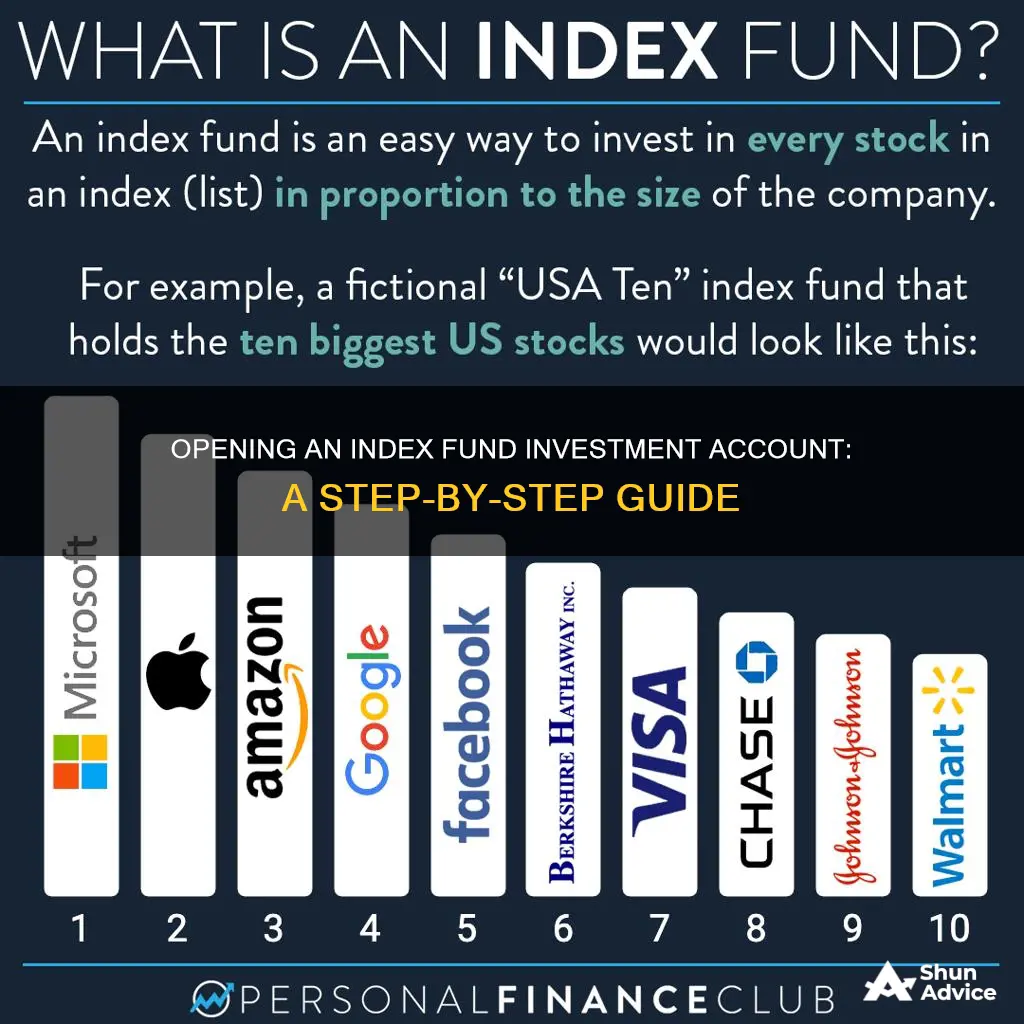
Index funds are a type of investment fund, such as a mutual fund or exchange-traded fund (ETF), that tracks a market index like the S&P 500 or the Russell 2000. They are a low-cost, low-risk way to build wealth over time, making them a popular choice for retirement investors.
To open an index fund investment account, you'll first need to decide on your investment goals and risk tolerance. You'll then need to research and choose a specific index fund to invest in, taking into account factors such as the fund's expense ratio and sales load. Once you've decided on a fund, you can open an investment account through a broker or investment app, fund your account, and make your first purchase.
| Characteristics | Values |
|---|---|
| Investment goals | Clear goals, especially when you hope to accomplish them |
| Index fund strategy | Right asset allocation, or the percentage of your portfolio comprising stocks vs. bonds, based on your timeline |
| Index fund type | Mutual fund or exchange-traded fund (ETF) |
| Index fund investment | Hundreds or thousands of different stocks and bonds |
| Index fund research | Types of indexes, individual funds that track them, fund fees, sales loads, expense ratios, investment minimums |
| Investment account | Education savings accounts, retirement accounts, taxable brokerage accounts |
| Index fund purchase | Check fund minimums, complete a trade ticket, choose market or limit price |
| Index fund performance | Check if the index fund is doing its job, monitor performance over time |
| Index fund exit strategy | No one holds an investment forever, consider capital gains taxes |
What You'll Learn

Pick your investment goals
Setting clear investment goals is crucial when opening an index fund investment account. Here are some essential considerations to help you define your investment objectives:
Time Horizon
Determine your time horizon, or how long you plan to invest for. Are you saving for a short-term goal, such as a down payment on a house, or are you investing for the long term, such as for retirement? Your time horizon will influence the types of index funds you choose and the level of risk you are willing to take. Generally, longer time horizons allow for riding out short-term market fluctuations and taking on more risk for potentially higher returns.
Risk Tolerance
Assess your risk tolerance, which refers to how comfortable you are with fluctuations in the value of your investments. Are you comfortable with more significant swings in the value of your portfolio, or do you prefer a more stable, steady approach? Risk tolerance is a personal assessment, and it's essential to be honest with yourself. Remember that higher risks may lead to higher returns but can also result in more substantial losses.
Financial Goals
Clearly define your financial goals. Are you investing to save for a specific purchase, such as a house or your child's education? Are you investing for retirement, or do you want to build wealth over time? Understanding your financial goals will help you choose the right types of index funds and create a plan to achieve those goals.
Investment Amount
Determine how much you can afford to invest. Consider your income, expenses, and financial commitments. Decide on a realistic amount that you can consistently invest, whether monthly, quarterly, or annually. Remember that investing in index funds typically requires a long-term commitment to ride out market fluctuations and maximize potential returns.
Diversification
Consider your desired level of diversification. Index funds themselves are already diversified since they track a specific market index and hold a basket of securities. However, you can further diversify your portfolio by investing in multiple index funds tracking different indexes. For example, you could invest in a mix of stock index funds and bond index funds to balance your portfolio.
Professional Guidance
Decide whether you want to manage your index fund investments yourself or seek professional guidance. You can choose to invest through an online brokerage platform, a robo-advisor, or a financial advisor. Each option has its advantages and considerations in terms of costs, control, and level of guidance.
Remember that your investment goals may evolve over time, and that's okay! Regularly review and adjust your investment strategy as needed to ensure it remains aligned with your changing circumstances and objectives.
High-Yield Bond Funds: Smart Investment, Higher Returns
You may want to see also

Choose an account type
When choosing an account type for your index fund investment, you should consider your savings goals and risk appetite. Here are some common types of accounts to choose from:
Education Savings Accounts
Education savings accounts, such as a 529 plan, are designed to help you save for education-related expenses. These accounts offer tax advantages and can be a great way to invest for your child's future education.
Retirement Accounts
Retirement accounts, such as an IRA, Roth IRA, or 401(k), are specifically meant for saving for retirement. These accounts often come with tax benefits, making them an attractive option for long-term investing.
Taxable Brokerage Accounts
If you're investing for goals other than retirement or education, a taxable brokerage account may be a suitable option. These accounts offer more flexibility in terms of investment choices and withdrawal options but may not provide the same tax advantages as retirement or education savings accounts.
When choosing an account type, it's important to consider the fees associated with each option. For example, some brokerages may charge a transaction fee for each trade, while others offer commission-free trading for certain funds. It's also essential to consider your investment horizon and risk tolerance. If you have a shorter time horizon, you may want to choose a more conservative investment strategy to reduce the risk of losses.
Additionally, you should consider the level of involvement you want in managing your investments. You can choose to manage your investments yourself through an online brokerage account or seek the help of a financial advisor or robo-advisor, who can provide guidance and manage your portfolio for you.
Overall, the choice of account type depends on your individual goals, risk tolerance, and investment strategy. It's always a good idea to do your research and compare different options before deciding which account type is best suited to your needs.
Lumpsum Mutual Fund Investment: Timing for Maximum Returns
You may want to see also

Research index funds
Index funds are a type of mutual or exchange-traded fund (ETF) that tracks the performance of a market index, such as the S&P 500, by holding the same stocks or bonds or a representative sample of them. Index funds are defined as investments that mirror the performance of benchmarks like the S&P 500 by mimicking their makeup.
Index funds are available across a variety of asset classes. Investors can buy funds that focus on companies with small, medium, or large capital values. Other funds focus on a sector, like technology or energy.
- Company size and capitalisation: Index funds can track small, medium-sized, or large companies, also known as small-, mid-, or large-cap indexes.
- Geography: Some funds focus on stocks that trade on foreign exchanges or a combination of international exchanges.
- Business sector or industry: You can explore funds that focus on specific sectors, such as consumer goods, technology, or health-related businesses.
- Asset type: There are funds that track bonds, commodities, or cash.
- Market opportunities: These funds examine emerging markets or other growing sectors for investment.
When researching index funds, it's important to consider the fund's expenses, as these can impact your long-term returns. Compare the expenses of different funds with similar investment goals, as costs can vary significantly.
Additionally, consider the fund's performance over the long term, ideally tracking at least five to ten years of performance. While past performance doesn't guarantee future results, it can give you an idea of potential future returns.
Other factors to consider include taxes, investment minimums, trading costs, fund options, and convenience.
- Fidelity ZERO Large Cap Index: 0% expense ratio, 16.0% five-year annualised return
- Vanguard S&P 500 ETF: 0.03% expense ratio, 16.0% five-year annualised return
- SPDR S&P 500 ETF Trust: 0.095% expense ratio, 15.9% five-year annualised return
- IShares Core S&P 500 ETF: 0.03% expense ratio, 16.0% five-year annualised return
- Schwab S&P 500 Index Fund: 0.02% expense ratio, 16.0% five-year annualised return
Investing 101: Choosing the Right Funds for Your Portfolio
You may want to see also

Open an investment account
Opening an investment account is the first step to investing in index funds. You can open an investment account with a wide variety of providers, including robo-advisors, online brokerages, and traditional brokers.
Robo-advisors
Robo-advisors offer a convenient, automated service that manages and rebalances a portfolio of diversified, low-cost index funds for you. While this option is more expensive than a DIY approach, it still costs a fraction of a traditional financial advisor's rate.
Online brokerages
Online brokerages such as Fidelity, Vanguard, TD Ameritrade, Charles Schwab, and Robinhood allow you to manually invest in funds yourself. These platforms often offer a wide range of investment choices, including index funds, mutual funds, and ETFs.
Traditional brokers
Traditional brokers can provide personalized advice and guidance to help you navigate the investment process. This option tends to be more costly than online brokerages or robo-advisors, but it may be a good choice if you want hands-on support.
When choosing a provider, it's important to consider factors such as account-related fees, investment minimums, and the range of investment options available. Additionally, look for providers that offer low expense ratios and no sales loads, as these fees can eat into your investment returns over time.
Once you've selected a provider, the process of opening an investment account is typically straightforward and can often be completed online within minutes. You'll need to provide personal information, such as your name, contact details, and Social Security number, and you may also need to fund the account during the setup process.
After opening your investment account, you can start purchasing index funds that align with your financial goals and risk tolerance. Remember to consider the fund's expense ratio, investment minimum, and historical performance when making your selection.
Mutual Fund Investment: Sweden's Guide to Getting Started
You may want to see also

Make your first purchase
Making your first purchase of an index fund is a simple process. You can set up your account to buy the index fund on autopilot, so you won't have to monitor the account, or you can enter your trades manually. Here is a step-by-step guide:
- Find your index fund: The first step is to select the index fund you want to invest in. The specific index fund you choose will depend on your financial goals, risk tolerance, and budget. Some common indexes that funds are based on include the S&P 500, Dow Jones Industrial Average, Nasdaq Composite, and Russell 2000. When selecting a fund, consider the expense ratio (the annual fee charged by the fund manager) and sales load (a commission charged by mutual funds).
- Go to your investing account or open a new one: You will need an investment account to purchase an index fund. Common types of accounts include a 401(k), IRA, Roth IRA, or a regular taxable brokerage account. If you don't already have an account, you can open one in about 10 to 15 minutes. Look for an account that matches your investment goals and consider factors such as fees, the availability of the funds you want to invest in, and the ease of use of the platform.
- Determine how much you can afford to invest: Figure out how much you are able to invest and how much you want to invest regularly. You don't need to be wealthy to start investing, but it's important to have a plan and stick to it. Consider how much you can afford to invest each week or month and set up regular transfers to your brokerage account.
- Buy the index fund: Once you know which index fund you want to buy and have set up your brokerage account, you can place your trade. Go to your broker's website and input the fund's ticker symbol (the alphabetical code for the fund) and the number of shares you want to buy, based on your budget. Many brokers allow you to set up recurring purchases, so you can invest in the fund on a regular basis without having to remember to place a trade each time.
- Set up a plan to keep investing regularly: Investing in an index fund is often part of a long-term strategy, so consider setting up a regular purchase plan. This will help you take advantage of dollar-cost averaging, reducing risk and increasing returns over time. You can also set up an investment review schedule to assess the performance of your index funds and rebalance your portfolio if needed.
A Guide to Investing in CPSE Exchange Traded Funds
You may want to see also
Frequently asked questions
An index fund is a type of investment fund – either a mutual fund or an ETF – that is based on an index. An index is a preset collection of stocks or bonds, and an index fund mimics the composition of the index, rather than trying to pick which stocks will outperform.
You can open an investment account with a broker that allows you to trade mutual funds or ETFs without transaction fees or commissions. You can then purchase shares of an index fund through this account.
There are many different types of index funds, including equity index funds, bond index funds, international index funds, and sector-specific index funds. Equity index funds track stock market indexes, such as the S&P 500 or Nasdaq-100. Bond index funds track bond indexes and may include assets like U.S. Treasuries or corporate bonds. International index funds follow indexes outside of the U.S., such as the FTSE Global All Cap ex US Index. Sector-specific index funds allow investors to gain some diversification while betting on a particular sector, such as technology or healthcare.







